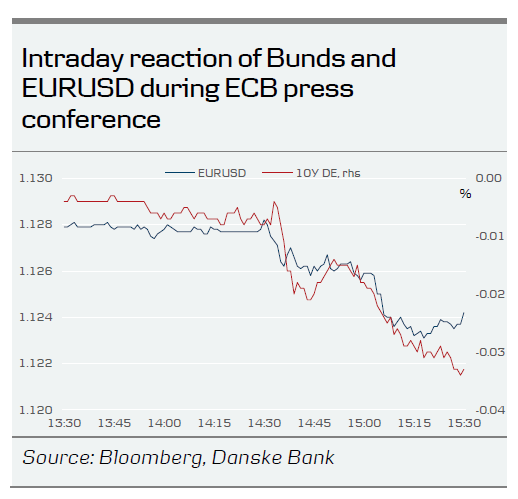- The ECB was on the dovish side today, with little new information in terms of policy signals, but it opened the door for further policy easing, in particular the tiering system.
- The pros and cons of the tiering system are still to be assessed, although Mario Draghi was very careful not to use the word ‘tiering’ as such.
- The Bund and EUR/USD traded lower throughout the press conference on the remit of a potential tiering system and a low-for-longer narrative.
Not much discussed today
The introductory statement was generally on the soft side and we take note, in particular, of the comment regarding mitigation of the negative side effects of negative interest rates. We cannot rule out a potential tiering system at a later stage but see this as more of a policy discussion that may unfold (see ECB Research – ECB Watchers conference: is a tiering system really the answer?, 28 March, for our reflections on a tiering system).
During the press conference, Draghi reflected that the GC meeting today was more of ‘stock taking’ nature about possible future policy actions and to reassert the ECB’s readiness to act if required, meaning all options are on the table.
Growth and inflation
On growth, Draghi sounded on balance slightly more downbeat than at the March meeting, saying today that ‘the slower growth momentum is expected to extend into the current year.’, which compares with March’s ‘…the near-term growth outlook will be weaker than previously anticipated’, i.e. the ECB expects a slightly longer time for pickup in the data. However, although the slower growth momentum was seen as extending further into the current year, the ECB still assesses the probability of a euro area recession as low.
The inflation outlook carried no new information. Draghi repeated his message of inflation expectations not being deanchored but only low. He said that 5Y5Y inflation swap deterioration reflects the deterioration in growth momentum. Similarly, he repeated his message on the negative inflation risk premium as an explanation of lower market-based inflation expectations.
Tiering and TLTRO3
There were no details or colour on the TLTRO3 that was announced at the March meeting, only a comment that it would come at the forthcoming meetings.
On tiering, there was some colour given that the ECB plans to consider measures to preserve the favourable implications of negative interest rates for the economy and to mitigate possible side effects, if any, on bank intermediation. Draghi did not want to use the word tiering as such but, in our view, markets took it quite clearly that he was referring to tiering. We repeat our view that a tiering system would make more sense if this implies only higher rates to help banks’ profitability but that we have to price a non-zero probability to tiering, which could include a cut as well. We recall that in 2016, the ECB did not announce a tiering system as it did not want to signal a cut.
FX: EUR/USD set to stay close to 1.13 in 3M
ECB President Draghi used to be known for his ability to intervene verbally in financial markets, e.g. during ECB press conferences. When he today stressed that the ECB intends to go after hitting its inflation target ‘without undue delay’, that the ECB can allow inflation to overshoot 2% and that all options are on the table, EUR/USD did not bite. This illustrates to us that words are not enough and that action is needed to weaken EUR and regain confidence in the market with regard to the ECB’s inflation target. EUR/USD decreased from around 1.1280 before the meeting to around 1.1230-40 in response to the market pricing the ECB to keep rates low for even longer. In our view, the ECB did not provide arguments for EUR/USD to fall much further from here and we stick to our call for the cross to trade around 1.13 in 3M.
Fixed income: implicit yield curve controller
The ECB continues to support the bond market, as the comments on the negative impact of negative policy rates suggest that rates will remain low for long. The ECB is still refraining from talking about ‘Japanification’ but the low rates makes investing in Europe attractive for foreign investors such as Japan due to the positive yield pickup from the FX hedge. Given Japanese investors purchase of European government bonds such as France and Finland, this is almost like ‘exporting’ yield curve control from Japan to Europe.
Hence, the message from the ECB is still supportive for spread compression between core EU and both semi-core and periphery. Furthermore, the curve is flattening between 2Y and 5Y, while there was a modest bullish steepening of the 5-10Y curves. However, a further flattening of 2Y-5Y would have a spillover effect to the 5-10Y curve. We continue to see 10Y Bund yields trading close to zero or even below for the rest of the year.
The rally in Italian government bonds continued on the back of the ECB comments and the 10Y spread continued to tighten despite the weak growth outlook presented by the Italian government yesterday. However, with investors starved for yield and no action from rating agencies, we believe there is room for more performance.














